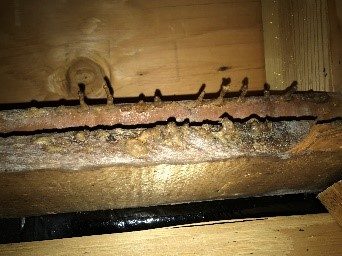Aside from an extremely unpleasant odor, bat guano and urine cause damage to structures aesthetically, chemically, and structurally.

Chemical Effect
Guano and urine have a chemical effect on building materials. Both substances contain high levels of uric and other acids. These acids can attack the calcium carbonate and other ‘binders’ in natural stone, artificial stone, and even concrete. They can corrode metal building materials such as copper or bronze and attack their protective patina. This can result in problems, both aesthetically and structurally! Salts

Although brick and other clay-based materials may be relatively resistant to acids, they are vulnerable to damage from salts. Guano contains high levels of phosphates, ammonium, potassium, chlorides, and other materials. These and the salts resulting from acid corrosion can result in severe problems of efflorescence* and breaking. Similarly, the effect of the acids and salts on the porosity of masonry and other materials can result in accelerated moisture and frost damage. The acid can also serve as a catalyst in the process of oxidation on nails, screws, and metal flashing’s around the structure.

Bat urine
Bat urine readily crystallizes at room temperature. In warm conditions under roofs exposed to sun and on chimney walls, the urine evaporates so quickly that it crystallizes in great accumulations. Boards and beams saturated with urine acquire a whitish powder-like coating. With large numbers of bats, thick and hard stalactites and stalagmites of crystallized bat urine are occasionally formed.

Fabrics & Insulation
Materials such as fabrics and insulation are extremely porous and susceptible to deterioration, thus leaving removal and replacement as the only viable solution for eliminating the guano and urine.
As already mentioned, bat guano and urine have a high concentration of uric and other acids, meaning that the guano and urine are extremely corrosive. This is especially true when there is repeated contact with surfaces such as metals and wood. Over a long period of time urine may cause wood deterioration. As the urine saturates the surfaces of dry wood beams and crystallizes, the wood fibers expand and separate. This can be quite severe, ultimately resulting in the need to replace such materials.

Attacks
Long-term exposure to bat urine can be problematic, particularly for softer stones like marble and travertine. These materials have a higher percentage of calcium carbonate that makes them more vulnerable to acidic compounds (like guano and urine). These acids attack the calcium carbonate and other ‘binders’ in natural stone, artificial stone, and even concrete. Granite and other hard surfaces can also be damaged, depending on the porosity and permeability of the material (granite’s that are lighter in color tend to be more absorbent). While the outside surface of granite is typically sealed after installation, the back and undersides of the material are left untreated and are vulnerable to damage (please note: even when sealed, granite may still be absorbent).
*efflorescence. A whitish, powdery deposit on the surface of rocks or soil in dry regions. It is formed as mineral-rich water rises to the surface through capillary action and then evaporates. Efflorescence usually consists of gypsum, salt, or calcite.

